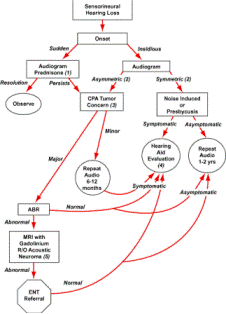








Table of
Contents
My Web Stats Until Dec 2008
| |
Sensorineural Hearing Loss
Caused by a disorder of the inner ear,cochlea,or VIII nerve
Range from mild to total,ie,greater than 120 dB HL
Nerve deafness or nerve loss
Etiology
Developmental & Hereditary disorder
- Congenital nerve deafness c loss at birth (endogenous, exogenous)
- Heriditary nerve deafness
- Heriditary disorder of adult deafness (Alport’s ,Waardenburg’s, Usher’s
syndrome)
- Inner ear abnormality (large vesibular aqueduct syndrome)
Toxic nerve deafness
- Toxic febrile nerve deafness
- Phamacological toxicity
Infectious disorder
- Syphilis : congental, acquired
- labyrinthitis : serous, supperative
- Viral : mump, measels, herpes zoster, CMV)
- Others : Rocky mountain, Spotted fever, Lyme disease
Trauma
- Noise induced HL & Acoustic trauma
- Head injury
- Barotrauma & perilymphatic fistula
- Irradiation
Meneire’s disease (Endolyphatic hydrops)
Central origin (Multiple sclerosis)
Bone disorder (cochlear otospongiosis)
Neoplesm (acoutic neuroma)
Endocrine (DM, congenital hypothyroid , hyperthyroid, hyperlipidemia)
disorder of unknown etiology(Presbyosis)
Others : vascular, immune disorder, renal, psycologic deafness)
Developmental & Hereditary disorder
Congenital nerve deafness c loss at birth
- Endogenous : FHx+ve, inheritary cochler defect
- Exogenous : During intrauterine life eg.Rubella, quinine, erytroblastosis,
hypoxia)
Hereditary nerve deafness
- Uncommon progressive symmetrical high tone SHNL in late childhood (same as
presbycusis)
Clinical : FH+, delay speech, G&D
High-risk Indicators of Hearing Loss : Birth to 28 days
- Family history of SNHL,
- presumably congenital In utero infection associated with SNHL (e.g.,
toxoplasmosis, rubella, cytomegalovirus, herpes, syphilis)
- Ear and other craniofacial abnormalities
- Hyperbilirubinemia at levels requiring exchange transfusion
- Birth weight less than 1,500 g
- Bacterial meningitis
- Low Apgar scores: 0 to 3 at five minutes; 0 to 6 at 10 minutes
- Respiratory distress (e.g., meconium aspiration)
- Prolonged mechanical ventilation for more than 10 days
- Ototoxic medication (e.g., gentamicin) administered for more than five
days or used in combination with loop diuretics
- Physical features or other stigmata associated with a syndrome known to
include SNHL (e.g., Down syndrome, Waardenburg's syndrome)
High-risk Indicators of Hearing Loss : 29 days to 24 months
- Parental or caregiver concern about hearing, speech or language, and/or
developmental delay
- Any of the newborn risk factors listed above
- Recurrent or persistent otitis media with effusion for at least three
months
- Head trauma with fracture of temporal bone
- Childhood infectious disease associated with SNHL (e.g., meningitis,
mumps, measles)
- Neurodegenerative disorders (e.g., Hunter syndrome) or demyelinating
diseases (e.g., Friedreich's ataxia, Charcot-Marie-Tooth syndrome)
Toxic nerve deafness
Most often found in childhood post acute febrile illness stage of severe
general infection eg. Measle, scarlet fever, influenza, pneumonia etc.
Typical Hx: normal hearing->sudden loss
Usually bilateral high frequency symmetrical and spontaneous(normal)
resolution
Pharmacologic toxicity
Aminoglycosides
most common caused, usually c nephrotoxic
Almost cochleotoxic (hair cell damage )> Vesibulotoxic except steptomycin &
gentamicin)
Antimalarial :SHNL
Quinine : tinnitus, nausea, visual-> “Cinchonism”
Chlroquine:macular degeneration
Large dose may be permanent HL
Salicylates
hearing return to normal in 72 hr
Infectious disorder
Congenital Syphilis n. deafness
Rapid progressive asymetric SHNL+/- vestibular symptom occurring several to
many years after chidhood interstitial keratitis
Hx,serology,VDRL,FTA-Ab
Rx:2sy benzathian PGs 2.4 mU IM,3 month c prednisolone40-80 mg/d daily then
decrease 10 mg q 2 day
Aquired syphilis n. deafness
often in late tertiry Sy positive blood serology Rx PGS IV
Labyrinthitis (serous/supperative)
Unilateral depression of cochlear function c vertigo and diplacusis
Young and middle aged
Recovery depends on severity
Serous labyrinthitis : secondary to ASOM or CSOM or surgical trauma
Supperative : with infection
Trauma
Noise induced HL
Prolong exposure to industrial or aircraf noise common progressive notching
bilateral at 4000 Hz from audiogram
Acoustic trauma
Single sharp sound of high intensity produce sudden unilateral permanent or
temporary high frequency SHNL

Meniere ‘s disease
Endolymphatic hydrops
Common disorder of endolymphatic labyrinth of inner ear
Unknown etiology
Fluctuating SHNL, roaring tinnitus, vertigo, sense of fullness in the ear,
recruitment and diplacusis
Low-pitched frequencies in early stage
Unilateral, 30-50 YO
Diagnosis :
- Hx
- otoscope, tunning fork
- neurological exam
- balance system and coornination
- water or air caloric stimulation
- electronystagmography
Management
- Low salt diet:<2,000 mg/day
- Medication
- Diuretics
- Antivertigo and antiemetic drugs
- Tranquillizer and sedatives
- Vasodilator
- Aminoglycoside injection when failure
Surgical treatment
- Hearing conservative surgery
- endolymphatic sac surgery (mastoid/ subarachnoid shunt)
- vestibular nerve neurotomy
- Hearing destructive surgery
General management
- Decrease stress
- Exersise especially Vestibular exercises
- Rest
- Avoidant : tea, coffee, alcohol, smoking, sunlight, environment
Central origin(Multiple sclerosis)
Chronic demyelination & inflammatory disease
Interruption of the auditory pathway
Various clinical manifestation but the common is sudden unilateral SNHL
Recovery days or weeks
Bone disorder : Cochlear otospongiosis
Unknown etiology
Progressive SNHL
Early or middle adult life
Positive FHx : stapes fixation
Related to the time of onset or degree fixation
Typical high tone loss
Neoplesm(acoutic neuroma)
Vestibular schwannoma
m/c neoplasm -> SNHL (earliest presentation)
Incidence 8-10 % of intracranial neoplasm
Unilateral slow progressive high frequency loss
Dizziness, tinnitus
May involve CN V, VII, cerebellar, brain stem
X-ray evidence of bone erosion or around IAM
Bilateral in von Recklinghausen’s multiple neurofibromatosis
Rx : surgery
Presbycusis
Progressive, bilateral, symmetrical
Degenerative disorder
Old aged
Sloping high tone loss to flatter audiogram with a loss for all frequency,
with variable impairment of speech discrimination


Summarized By Thirayost Nimmanon
â´Â ¸ÕÃÂÊ¶ì ¹ÔÁÁÒ¹¹·ì
 
|
